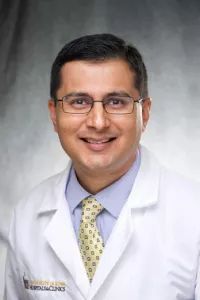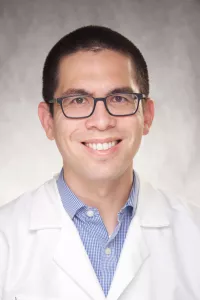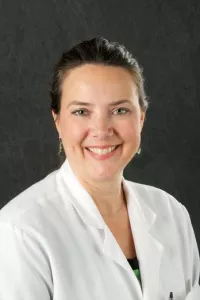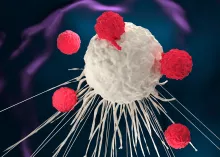Stem Cell Transplant and Cellular Therapy Program
The Stem Cell Transplant and Cellular Therapy Program at University of Iowa Health Care in Iowa City, Iowa has been performing stem cell transplants since 1980. The program has earned reaccreditation from the Foundation for the Accreditation of Cellular Therapy (FACT), putting Iowa's Stem Cell Transplant and Cellular Therapy Program on a select list of institutions that meet the most rigorous standards in every aspect of stem cell therapy, including clinical care, donor management, cell collection, processing, storage, transportation, administration, and cell release.
A bone marrow transplant is a procedure to replace damaged or destroyed bone marrow with healthy bone marrow stem cells. Bone marrow is the soft, fatty tissue inside your bones. Stem cells are immature cells in the bone marrow that give rise to all of your blood cells.
Alternative names
There are several alternative names for a blood and marrow transplant, including:
- Bone marrow transplant
- Stem cell transplant
- Hematopoietic stem cell transplant
- Reduced intensity, nonmyeloablative transplant
- Mini transplant
- Allogenic bone marrow transplant
- Autologous bone marrow transplant
- Umbilical cord blood transplant
Types of Cellular Therapies and Stem Cell Transplants
Our experienced team has provided over 4,000 stem cell transplants—adult, pediatric, allogeneic and autologous—since 1980. Learn more about why the UI Stem Cell Transplant and Cellular Therapy Program is your best choice for care.
There are three kinds of bone marrow transplants:
The term auto means self. Stem cells are removed from you before you receive high-dose chemotherapy or radiation treatment. The stem cells are stored in a freezer (cryopreservation). After high-dose chemotherapy or radiation treatments, your stem cells are put back in your body to make (regenerate) normal blood cells. This is called a rescue transplant.
The term allo means other. Stem cells are removed from another person, called a donor. Most times, the donor's genes must at least partly match your genes. Special blood tests are done to see if a donor is a good match for you. A brother or sister is most likely to be a good match. Sometimes parents, children, and other relatives are good matches. Donors who are not related to you may be found through national bone marrow registries.
This is a type of allogeneic transplant. Stem cells are removed from a newborn baby's umbilical cord right after birth. The stem cells are frozen and stored until they are needed for a transplant. Umbilical cord blood cells are very immature so there is less of a need for matching. But blood counts take longer to recover.
There are currently two types of cellular therapy treatments:
CAR T-cell therapy, primarily employed to treat blood cancers, utilizes naïve T cells that do not specifically target a tumor. T cells are obtained from the patient’s blood and are engineered in the lab to produce a CAR protein, which enables T cells to target and attack cancer cells more effectively by binding to specific proteins on their surface.
TIL therapy uses T cells isolated from surgically removed material next to or within the tumors. The cells are then tested in a lab to identify which ones best recognize the tumor, and those cells are grown in large quantities.
Types of Bone Marrow Treatments
Before the transplant, chemotherapy, radiation, or both may be given. This may be done in two ways:
Ablative (Myeloablative) Treatment
High-dose chemotherapy, radiation, or both are given to kill any cancer cells. This also kills all healthy bone marrow that remains, and allows new stem cells to grow in the bone marrow.
Reduced Intensity Treatment (Mini Transplant)
Patients receive lower doses of chemotherapy and radiation before a transplant. This allows older patients, and those with other health problems to have a transplant.
A stem cell transplant is done after chemotherapy and radiation is complete. The stem cells are delivered into your bloodstream usually through a tube called a central venous catheter. The process is similar to getting a blood transfusion. The stem cells travel through the blood into the bone marrow. Most times, no surgery is needed.
Our Providers Use Stem Cell Transplant as Treatment for Several Disease Types:
| Disease | Type of Transplant |
|---|---|
| Hodgkin lymphoma (HL) | ALLO or AUTO |
| Non-Hodgkin lymphoma (NHL) | ALLO or AUTO |
| Myelodysplastic/myeloproliferative diseases (MDS/MPN) | ALLO |
| Acute myelogenous leukemia (AML) | ALLO |
| Acute lymphocytic leukemia (ALL) | ALLO |
| Multiple myeloma/plasma cell disorder (PCD) | AUTO |
| Solid tumors (ST) (Specific tumors listed below) | AUTO |
| Chronic myelogenous leukemia (CML) | ALLO |
| Severe aplastic anemia (SAA) | ALLO |
| Histiocytic disorders (HD) | ALLO or AUTO |
| Disorders of immune system (including auto-immune disorders) | ALLO or AUTO |
Solid Tumors Treated
Adult Solid Tumors
- Ewing family tumors of bone, including PNET (a type of sarcoma, or bone and soft tissue cancer)
- Testicular cancer, germ cell tumor, extragonadal (rare tumors found in the ovaries or testes)
- Sarcomas
Pediatric Solid Tumors
- Central nervous system tumor, including CNS PNET, Pinealoblastoma
- CNS PNET primitive neuroectodermal tumor
- Esthesioneuroblastoma (a rare cancer in the nasal cavity)
- Ewing family tumors of bone, including PNET (a type of sarcoma, or bone and soft tissue cancer)
- Medulloblastoma (a brain tumor)
- Neuroblastoma (a cancer in the nerve cells)
- Other, specify ATYPICAL TERATOID/RHABDOID TUMOR (a rare tumor of the central nervous system)
- Wilm Tumor (a rare kidney tumor)
Patient Eligibility
Most patients receiving a stem cell transplant are in their fifties and sixties. Sometimes, they are a little older. Transplantation is a very intensive therapy, and we need to have some reassurance that patients have a good chance of surviving and will not succumb to such intensive therapy. We try to maximize success and minimize the risk of patients actually having their life shortened by a stem cell transplant.
To assess the fitness of a patient to receive a transplant, we test:
- Heart function (Echocardiogram and EKG)
- Lung function (pulmonary function tests and arterial blood gases)
- Liver function (blood work)
- Kidney function (blood work)
In addition, we will ensure that there is no active infection by doing blood work and imaging tests such as CT chest, CT sinuses and/or PET-CT scan. These tests are arranged prior to the first clinic visit so that the results can be reviewed and decisions can be made about treatment options during the visit with the specialist.
Our Care Team






- Cancer

- Cancer

- Cancer

- Cancer

- Cancer


- Cancer
Not sure which Stem Cell Transplant and Cellular Therapy Program provider is right for you?
Locations and Offices

Patient Stories



Support Groups
For caregivers, this group will be a blend of open discussion, as well as educational information to help with practical advice and guidance from both health-care professionals and other caregivers themselves.
For adult patients with leukemia, lymphoma, Hodgkin's disease, myeloma, or myelodysplastic syndromes and their family and friends
This gathering offers support and open discussion around a diagnosis of leukemia, Hodgkin lymphoma, non-Hodgkin lymphoma or multiple myeloma for patients, family members, friends and survivors.
Affiliated with Leukemia and Lymphoma Society
Provides free house cleaning once per month for four months during the time the woman is in treatment, and helps women who are going through cancer treatment
Offered by UI Health Care's Blood and Marrrow Transplant Program for patients and caregivers.
A group or individual counseling program for people with cancer and/or their families. Patients and family members are welcome to come to group counseling or may set up individual appointments.
Call for more information on meeting dates and locations.